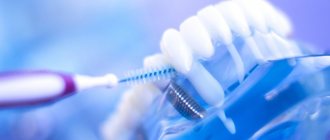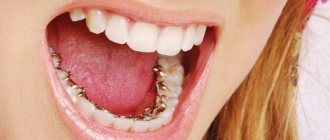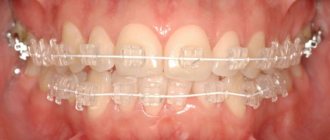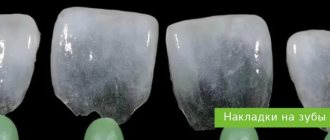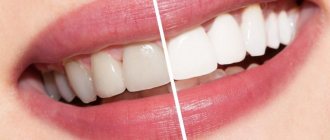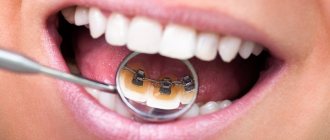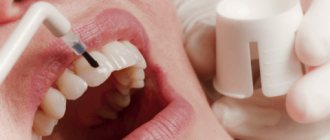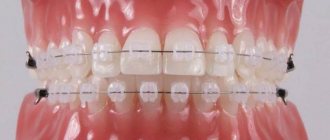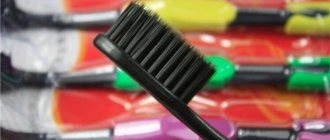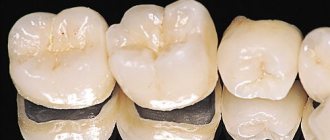One of the main ways to correct bites in adults today is vestibular, or external braces. And in everyday life we simply call them in one word - “braces”. They are fixed on the outer surface of the teeth and all the surrounding structures on the teeth are visible when the patient smiles. Something like this (see photo)
You can discuss the pros and cons for as long as you like, since they have their own advantages and disadvantages, like any bite correction system. But there are several main points. And you need to know them.
There are four advantages of external braces when correcting malocclusion:
- Firstly
, today vestibular braces are the most functional device that orthodontists can use in adults. - Second plus
. Treatment with braces really gives a fairly quick visual effect. - Thirdly
, external braces provide probably the greatest expansion. - The fourth plus
is that in terms of cost, they are probably one of the most affordable options for correcting a bite, which is important for adults.
The disadvantages are that, no matter what kind of braces orthodontists choose - metal or so-called aesthetic (transparent), ceramic, sapphire - when correcting a bite, the disadvantages are the following.
Disadvantages of external braces when correcting bites in adults:
- Firstly
, any external braces are still visible, and this very often influences the choice by adults of one or another method of treating malocclusion.
- Second minus
. In addition, of course, they contribute to the accumulation of plaque, which means hygiene is significantly reduced. And the accumulation of plaque leads to tooth decay. Therefore, you have to carefully clean your teeth and braces using special brushes. This is really tiring and it is never possible to completely clear the plaque (if you also violate your diet - see the fourth minus)
- The third disadvantage
: braces really rub the mucous membrane, especially at first they can strongly rub the mucous membrane of the cheeks and lips.
- Fourthly
, external braces also impose restrictions on the intake of hard foods, be it meat, apples, and so on.
- Fifth minus
. From the point of view of psychological comfort, vestibular braces are also, of course, constraining.
Pros and cons of braces according to doctors' reviews
Real reviews from doctors about the pros and cons of braces boil down to the fact that the main advantage of these devices is their ability to correct even the most complex malocclusions, unlike other orthodontic devices, and the disadvantage is the difficulty of care and aesthetic qualities (with the exception of certain types of braces) . In addition, experts do not advise choosing braces based on numerous tables on the Internet, which compare treatment periods for different types of braces and prices for these designs. Why?
Firstly, every patient must understand that the degree of impact on the teeth and the duration of the correction process are the same for all braces. This is due to the natural mechanism of tooth movement. Secondly, the following can be said about the cost of braces. There are clinics that offer expensive sapphire braces for the price of ceramic ones. And it's not a joke. It’s just that the cost of orthodontic structures and services for their use depends on the pricing policy of dentistry, and not on the quality of braces or the qualifications of the doctor. Therefore, in our article we will, of course, talk about approximate prices for this or that type of braces, but, basically, we will evaluate bracket systems according to the following criteria:
- aesthetics;
- reliability;
- comfort of wearing;
- ease of care.
Interesting fact!
According to rumors, scientists at Oxford University are working on creating magnetic braces. They say that the principle of their operation will be based on the creation of a constant magnetic field using two miniature generators, which will act on the iron contained in the teeth and effectively correct the bite without the need to wear any structures.
Sixth, intimate minus
We specifically highlighted this minus as a separate item. Doctors tactfully remain silent about this drawback of any brace systems, including lingual ones. But it exists. And it causes a lot of problems for their owners. This is injury, but not to the tongue, but injury to parts of the mucous membrane of the sexual partner during intimate caresses: causing micro-scratches with possible infection of the wounds due to insufficient hygiene of braces.
Such statistics are periodically published in the European and American press, where they really and openly talk about it. With aligners, this problem is absent or minimized: we always try to brush our teeth normally, but with braces it becomes increasingly more difficult to clean. And remember that you will live with this problem side by side for the entire duration of treatment - from a year to 3 years. It suits you?
Type of braces
Ligature braces
- the elasticity of the ligatures ensures more comfortable wearing of braces.
- affordable price.
- It is necessary to change the ligatures regularly (about once a month), as they stretch while wearing braces.
- a more complex hygiene procedure due to the presence of ligatures.
Braces without ligatures
- There is no need to replace ligatures, so you can visit the doctor less often.
- Easier oral care routine.
- are more expensive than ligature braces.
Contraindications
The procedure for installing ceramic braces has a number of contraindications, which can be relative or absolute:
- The first group includes caries, non-compliance with the rules of personal oral hygiene, hypersensitivity and allergic reactions to the material of the structure being installed, and dental diseases of inflammatory origin. When treating the above ailments, wearing braces may be allowed - this issue should be decided by your attending physician.
- Conditions in which it is strictly forbidden to carry out this procedure are the absence of healthy teeth that will support braces and can withstand all the stress, diseases of the blood, immune, endocrine system, tuberculosis, damage to the bone apparatus.
Ceramic braces - pros and cons
These orthodontic systems are made from dental ceramics. Having analyzed the pros and cons of non-ligature and ligature ceramic braces, we can conclude that such brace systems represent good value for money, allowing you to solve any bite problems at an affordable price, which in Moscow clinics is about 30,000 rubles for the design itself. one row of teeth. In this case, diagnostics, installation and removal of the system will have to be paid additionally.
Reaching a new goal
Perhaps you are faced with a difficult choice: on the one hand, you are embarrassed about your smile, on the other, you do not want to wear braces for 1 to 3 years. But the faster you start, the faster you finish. As they say, the best time to do this is yesterday, the second best time is today. Moreover, you will experience great joy as you systematically move towards your goal, seeing how your teeth are straightened month after month, and in the end you will get the long-awaited result - a beautiful smile. This experience will certainly be useful in other areas of life.
Sapphire braces - pros and cons
These are transparent braces made from artificial sapphire, which really do not spoil the patient’s appearance, but look like a stylish accessory. As for the pros and cons of sapphire braces, their main advantage is considered to be high aesthetics, and a significant disadvantage is the price, since most often they cost much more than ceramic ones. However, there are cheaper options for sapphire designs combined with metal or ceramic. Thus, the cost of braces made entirely of sapphire starts in Moscow clinics from 70,000 rubles per design for one row of teeth.
Popular myths
1. It's not nice. There is a myth that fixed appliances do not look very aesthetically pleasing, and the person wearing them cannot look attractive. But modern braces do not affect the aesthetics of a smile. Firstly, there are lingual braces that are completely invisible to others. Secondly, even external braces can be beautiful: sapphire, ceramic, and plastic structures can even add a certain charm to your smile.
2. Braces are only for children. Many patients still have associations with braces - teenage schoolchildren. But it has no basis. Children and adolescents have more options and correction methods, and removable orthodontic appliances are more often used. Adults with a mature dental system have fewer options - braces are used more often as a powerful tool. It is worth noting that there are no upper age restrictions for braces - they are successfully used at both 25 and 60 years old. The older the patient, the longer the retention period, that is, the result will have to be consolidated longer, and this is the only age difference;
3. It hurts. This myth has a reasonable explanation; indeed, pain and discomfort do occur, but not all the time. It may be painful the first few days after installation. This is a normal symptom that occurs as a result of pressure on the teeth. Most patients report moderate pain and itching in the gums, which go away on their own and do not require correction with medications. But everyone has their own pain threshold and perception of pain, so the doctor will tell you how to get rid of unpleasant sensations.
4. It's harmful. It is believed that the non-removable structure destroys the teeth. But preliminary diagnosis is needed in order to assess the strength of the enamel and the risks of complications. Normal enamel can withstand the structure, and compliance with hygiene and doctor’s recommendations eliminates the risk of developing caries in areas of the teeth near braces.
Type of braces
Lingual
- completely invisible.
- as durable as metal systems.
- are more expensive than ceramic braces.
- They are more difficult to maintain than labial systems, which are attached to the outside of the teeth.
- significantly affect diction.
Of course, the above pros and cons of braces will play an important role in shaping your preferences regarding one or another type of these orthodontic structures. However, we will tell you a secret: the best braces for each patient will be those that will help him solve his particular bite problems. Therefore, an experienced and knowledgeable orthodontist will help you choose the right bracket system after examining and diagnosing your teeth.
What lengths do aligner manufacturers now go to in order to divert patients' attention from braces?
There are good discounts, free consultations, and even free modeling of a future smooth and beautiful smile. But most people, out of established habit, still choose braces as the main way to correct their bite. In any case, whichever method you choose now, this is the first step towards solving the problem of crooked teeth and entering a new world of opportunities that will open up your beautiful smile. And by the way, you can sign up for a free consultation and 3D smile modeling in your city by filling out the form below this article. Star Smile specialists will select a specialized orthodontic center for you in close proximity to your residence. By the way
, you can find out in 1 minute whether aligners are right for you at all or whether doctors will forcefully offer only braces: you need to answer only
9 express questions
.
Systems for teenagers
Orthodontics in Moscow continues to constantly develop. Anyone can correct their bite, and it is best to do it in childhood or adolescence. And which dental braces to choose, the price of which will be optimal, but at the same time the designs will perfectly perform their functional duties? Here we must be guided by the peculiarities occurring in the body of a teenager.
At this age, a person has a lack of calcium and fluoride. Teenagers often bite their nails, chew gum, and have many other bad habits that lead to a crooked bite. And due to the lack of microelements important for teeth in the body, a person at this age can easily develop an anomaly.
If these indications for treatment exist, the teenager needs to have braces installed on his teeth (the cost of each system varies):
- there are gaps between the teeth;
- the dentition is crooked;
- there is an urgent need for treatment.
Bracket systems are installed, the cost of which depends on their material of manufacture and much more, in several stages. If treatment is required for a child under nine years of age, the doctor performs the procedure and then monitors the child for several years. Then the installation of other braces is carried out during adolescence. The need for this is due to the growth of the jaw.
To make a choice in favor of one or another braces, you need to familiarize yourself with the advantages and disadvantages of each of them. Let's start with metal ones. Such lower and upper braces have the following advantages:
- small thickness;
- quite comfortable to wear;
- the mucous membrane is not injured;
- ease of care;
- strength;
- durability;
- low cost.
As you can see, such a brace system has many advantages; the price in this case is one of the main advantages. But there is one drawback - unaesthetic.
Products made from composite material are quite fragile and therefore short-lived. Ceramic, on the contrary, are highly durable. At the same time, they are aesthetically pleasing, as they are invisible to the eye and are firmly attached to the enamel. But the prices for such braces (Moscow) are quite high. It is also worth noting that they are not picky in their care: you need to look after them very carefully.
Lingual braces, as we have already said, have many advantages. But they can only be installed by adults. The fact is that they are attached to the inside of the teeth, which is an undeniable advantage, but they take a long time to get used to, so teenagers should not use them.
Pain after removal
People who have completed treatment to correct their bite and are concerned about pain often come to our orthodontic center. Let us immediately reassure you that you will experience discomfort for no longer than two weeks. Why does this happen - what causes teeth pain? The fact is that over many years the teeth have become accustomed to the position in which they were before treatment. And after removing the braces, they try to return to the incorrect original position.
A person may experience discomfort for another reason - due to weakened enamel. To get rid of discomfort, the doctor applies a special varnish, gel and paste to the teeth. These products quickly restore the enamel, so the pain goes away.
What is a retainer?
A retainer is a small arch that is placed on the inside of the teeth after braces are removed. That is, it consolidates the result of treatment of malocclusion. Retainer placement is required for all patients over 25 years of age. You have to wear it for a long time - twice as long as wearing braces. It is believed that the optimal period is four years. After this time, the person must wear a mouthguard at night.
And all these procedures must be performed without fail, otherwise the result of the treatment will not be consolidated. A person must realize that changes in the functioning of the body must be completed. Otherwise, correcting the bite with braces will be done in vain.
The impact of malocclusion on health
Malocclusion has a negative impact on human health. We don’t think it’s worth talking about the aesthetic component. Of course, there are no life-threatening indicators, but it is still necessary to get rid of the anomaly, otherwise it will lead to disastrous consequences. First of all, the impact falls on the gastrointestinal tract. This happens due to the fact that a person’s chewing function is impaired. Correcting your bite with braces will help you avoid digestive problems. There are just some contraindications for installation:
- infectious diseases of the oral cavity;
- different sizes of teeth;
- allergies (occurs extremely rarely to metal, but in this case it is possible to install, for example, ceramic structures).
Restoring enamel after braces
The aesthetic consequences of braces can be successfully eliminated using the following procedures:
- professional cleaning;
- teeth whitening;
- installation of retainers with a special composition that strengthens the enamel;
- polishing and processing of enamel with special solutions.
Doctors' opinion
On various forums you can find many reviews that the installation of braces negatively affects the condition of the enamel, provoking the development of caries and triggering the process of leaching of useful microelements and mineral salts from the protective layer of teeth - demineralization of the enamel and destruction of its organic matrix. This pathological process is complex and leads to rotting of the hard tissues of the tooth.
This information is partly correct. But experts are unanimous in the opinion that such a clinical picture is caused in most cases by the human factor.
The initial degree of development of caries from wearing braces is excluded for two reasons:
|
Remarkable!
The hardest layer of the crown of the tooth under the clasp is tightly closed from the penetration of pathogenic microorganisms. Thus, it becomes clear that the enamel can be destroyed not under the bracket, but around it.
Do your teeth hurt during treatment?
After braces are installed, the cost of which in Moscow can vary significantly depending on the clinic, a person may begin to experience discomfort. What is this connected with? This reaction is quite normal. People may experience discomfort for up to seven days. To ease the “suffering”, you can take an anti-inflammatory drug. It should be prescribed by a doctor - under no circumstances should you self-medicate.
Unpleasant sensations are normal. The gums need to get used to braces - a foreign object. To alleviate the condition, you can use a saline solution. How to cook it? Dissolve a couple of teaspoons of salt in a glass of water and rinse your mouth with the solution at least twice a day.
If your teeth become more sensitive after getting braces, avoid eating hard foods. Eat soft foods: mashed potatoes, yogurts, soups, etc. If the pain worsens, you can eat something cold.
FAQ
How does the oval of the face change after braces?
The face after braces becomes more symmetrical and proportional. This is a consequence of correcting the bite. For example, if a patient’s teeth do not close together and the face appears elongated, then after correction with braces the cosmetic defect is eliminated. Most often, after such treatment, the cheekbones become more expressive and the cheeks become sunken.
Is it possible not to wear retainers after braces?
Can. However, the consequences of such a decision are difficult to predict. The teeth will again try to return to their previous position. And then, 1-2 years of correction with braces will be useless.
Do braces make your lips look bigger?
Visually, yes, because there is a bracket arch under the lip. However, after removing the structure, the effect of lip augmentation disappears.
Do teeth fall out from braces?
No, they don't fall out. And information about this is just rumors that have no basis.
Does it hurt to get braces? Let's figure it out!
Does it hurt to put braces on children 13 years old? Is installing a system painful at 14 years old? Does it make a difference when to see a doctor? In fact, the installation algorithm does not depend on age, and always includes the following orthodontic manipulations:
- Cleaning the teeth with a special paste and covering the crown with a composition that increases enamel adhesion.
- Fixation of rings or locks on the distant chewing teeth, which are responsible for fastening the end parts of the arch.
- Gluing plates - correcting the position of the element and removing glue residues.
- Installation of a metal corrective arch into the grooves of the braces.
- Fastening the arch - with ligatures or using snap clasps.
The work is painstaking, requiring a thorough approach on the part of the dentist, but completely painless for the patient. The only discomfort at this stage is the need to keep your mouth open. The installation of a brace system on one jaw takes about an hour, so the orthodontist usually prescribes two appointments so as not to tire the patient and make it easier for him to adapt to the device.
Plaksina Margarita
“I install braces in two steps, with the interval between meetings reaching 3-6 months. This approach has great advantages: the child does not need to sit in a chair with his mouth open for 2-3 hours - that’s it. Accelerated adaptation to braces, reduction of discomfort during the adaptation period – two and three.”
